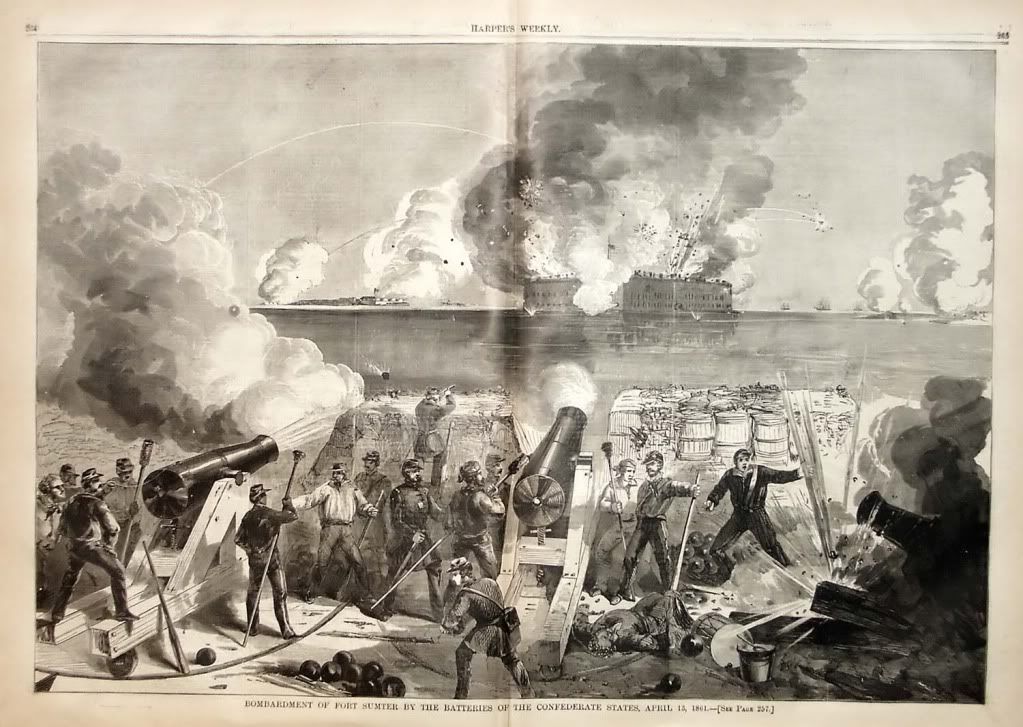
Fort Sumter attack on April 13, 1865 shown in Harper's Weekly newspaper.
Image Courtesy Charleston Battery Tour.
Today marks the 150th Anniversary of the first shots of the American Civil War, or as people around here like to call it, The War of Northern Aggression.
Here are a few tidbits of information, links and videos regarding The Battle of Fort Sumter that took place from April 12th to the 13th in the year 1861...
The Battle of Fort Sumter (April 12–13, 1861) was the bombardment and surrender of Fort Sumter, near Charleston, South Carolina, that started the American Civil War. Following declarations of secession by seven Southern states, South Carolina demanded that the U.S. Army abandon its facilities in Charleston Harbor. On December 26, 1860, U.S. Major Robert Anderson surreptitiously moved his small command from the indefensible Fort Moultrie on Sullivan's Island to Fort Sumter, a substantial fortress controlling the entrance of Charleston Harbor. An attempt by U.S. President James Buchanan to reinforce and resupply Anderson, using the unarmed merchant ship Star of the West, failed when it was fired upon by shore batteries on January 9, 1861. South Carolina authorities then seized all Federal property in the Charleston area, except for Fort Sumter.
During the winter months of 1861, the situation around Fort Sumter increasingly began to resemble a siege. In March, Brig. Gen. P.G.T. Beauregard, the first general officer of the newly formed Confederate States of America, was placed in command of Confederate forces in Charleston. Beauregard energetically directed the strengthening of batteries around Charleston harbor aimed at Fort Sumter. Conditions in the fort grew dire as the Federals rushed to complete the installation of additional guns. Anderson was short of men, food, and supplies.
The resupply of Fort Sumter became the first crisis of the administration of President Abraham Lincoln. He notified the Governor of South Carolina, Francis W. Pickens, that he was sending supply ships, which resulted in an ultimatum from the Confederate government: evacuate Fort Sumter immediately. Major Anderson refused to surrender. Beginning at 4:30 a.m. on April 12, the Confederates bombarded the fort from artillery batteries surrounding the harbor. Although the Union garrison returned fire, they were significantly outgunned and, after 34 hours, Major Anderson agreed to evacuate. There was no loss of life on either side as a direct result of this engagement, although a gun explosion during the surrender ceremonies on April 14 caused two Union deaths.
Following the battle, there was widespread support from both North and South for further military action. Lincoln's immediate call for 75,000 volunteers to suppress the rebellion resulted in an additional four states also declaring their secession and joining the Confederacy. The Civil War had begun.
Source: Wikipedia
For more information, visit the National Park Service Fort Sumter website.
Civil War re-enactors fire cannon from the Old Pitt Street Bridge in Mt. Pleasant toward Fort Sumter on the morning of April 12, 2011 marking the 150th anniversary of the first shots of the American Civil War.
This C-SPAN program is part of the 150th anniversary of the beginning of the Civil War on April 12, 1861.
After finishing with his survey of the manner in which historians have explained the coming of the Civil War, Professor Blight focuses on Fort Sumter. After months of political maneuvering, the Civil War began when Confederates fired on Fort Sumter, in the harbor outside Charleston, SC. The declaration of hostilities prompted four more states--Virginia, Tennessee, North Carolina, and Arkansas--to secede. Professor Blight closes the lecture with a brief discussion of some of the forces that motivated Americans--North and South--to go to war.






























1 comments :
Given that there was and still is no defined legal procedure for secession, the question was at best in ambivalence at the time of the Civil War. So yes, how many people could be persuaded to accept secession as a state right is relevent. As a result of the War, the answer is that no state has a right to secede.
Post a Comment